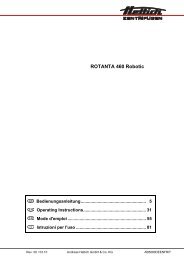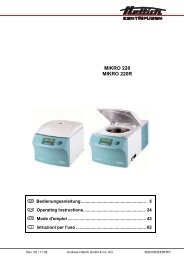ROTINA 420 ROTINA 420 R - Hettich Instruments
ROTINA 420 ROTINA 420 R - Hettich Instruments
ROTINA 420 ROTINA 420 R - Hettich Instruments
You also want an ePaper? Increase the reach of your titles
YUMPU automatically turns print PDFs into web optimized ePapers that Google loves.
EN<br />
4 Notes on safety<br />
No claim of warranty will be considered by the manufacturer unless ALL instructions in this manual<br />
have been followed.<br />
• The centrifuge should be installed on a good, stable base.<br />
• Before using the centrifuge absolutely check the rotor for firm placement.<br />
• When the centrifuge is running, according to EN / IEC 61010-2-020, no persons, dangerous<br />
substances or objects may be within the safety margin of 300 mm around the centrifuge.<br />
• Rotors, suspensions and accessories that possess traces of corrosion or mechanical damage or<br />
if their term of use has expired may not be used any longer.<br />
• The centrifuge may no longer be put into operation when the centrifuging chamber has safetyrelated<br />
damages.<br />
• With swing-out rotors the trunnions must be regularly lubricated (<strong>Hettich</strong> Lubricating Grease No.<br />
4051) in order to ensure consistent swinging out of the hangers.<br />
• Before the initial operation of your centrifuge you should read and pay attention to the operating<br />
instructions. Only personnel that has read and understood the operating instructions are allowed to<br />
operate the device.<br />
• Along with the operating instructions and the legal regulations on accident prevention, you should also follow the<br />
recognised professional regulations for working in a safe and professional manner. These operating instructions<br />
should be read in conjunction with any other instructions concerning accident prevention and environmental<br />
protection based on the national regulations of the country where the device is to be used.<br />
• This centrifuge is a state-of-the-art piece of equipment which is extremely safe to operate. However, it can lead to<br />
danger for users or others if used by untrained staff, in an inappropriate way or for a purpose other than that it<br />
was designed for.<br />
• The centrifuge must not be moved or knocked during operation.<br />
• In case of fault or emergency release, never touch the rotor before it has stopped turning.<br />
• To avoid damage due to condensate, when changing from a cold to a warm room the centrifuge must either heat<br />
up for at least 3 hours in the warm room before being connected to the mains, or run hot for 30 minutes in the<br />
cold room.<br />
• Only the rotors and accessories approved by the manufacturer for this device may be used (see chapter<br />
"Anhang/Appendix, Rotoren und Zubehör/Rotors and accessories").<br />
• The centrifuge rotor may only be loaded in accordance with the chapter "Loading the rotor".<br />
• When centrifuging with maxim revolutions per minute the density of the materials or the material mixtures may not<br />
exceed 1.2 kg/dm 3 .<br />
• The centrifuge may only be operated when the balance is within the bounds of acceptability.<br />
• The centrifuge may not be operated in explosion-endangered areas.<br />
• The centrifuge must not be used with:<br />
− inflammable or explosive materials<br />
− materials that react with one another producing a lot of energy.<br />
• If users have to centrifuge hazardous materials or compounds contaminated with toxic, radioactive or pathogenic<br />
micro-organisms, they must take appropriate measures.<br />
For hazardous substances centrifuge containers with special screw caps must strictly be used. In addition to the<br />
screw cap centrifuge containers, for materials in hazard category 3 and 4 a biosafety system must be used (see<br />
the World Health Organisation’s “Laboratory Biosafety Manual”).<br />
In a biosafety system, droplets and aerosols are prevented from escaping by a bioseal (packing ring).<br />
If the hanger of a biosafety system is used without the lid, the packing ring must be removed from the hanger in<br />
order to prevent the packing ring from being damaged during the centrifugation run. Damaged packing rings must<br />
not be used to seal the biosafety system.<br />
Without the use of a biosafety system the centrifuge is not microbiologically sealed in the sense of the<br />
EN / IEC 610101-2-020 standard.<br />
34/136
















